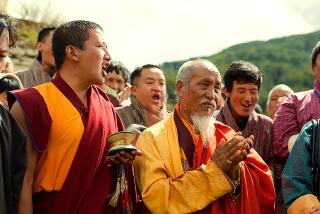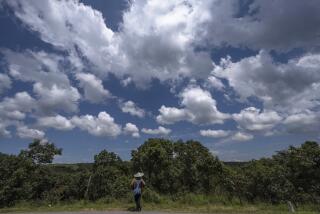Contributing to the Gross National Happiness in Bhutan
Reporting from Thimphu, Bhutan — — Bhutan? Just telling people I was coming to Bhutan evoked wonder. Some extolled it as “the true Shangri-La” and the home of “pure Buddhism,” incredible trekking, pristine environments, authentic culture and Gross National Happiness, or GNH — the Bhutanese indicator of quality of life. Others looked at me as if I had announced a trip to a new exo-planet.
I wanted to enjoy firsthand the beauty of the land-locked Himalayan kingdom, as well as the social experiments of an ancient culture that adopted democracy — without violence — in 2007.
Last autumn I flew from LAX to Bangkok, Thailand, where I boarded a Royal Drukair airliner, Bhutan’s only regular carrier. The steep descent to its international airport, outside the town of Paro, is considered one of the scariest approaches in the world. Seeing the plane’s wings nearly brush the trees on the mountains seemed appropriate in a realm whose new constitution mandates that a majority of the land be preserved in its natural state.
After hours of flying and clearing passport control, I was greeted by Tshering Phub, my guide, and Karma, our driver. They were part of my Bridge to Bhutan package and participants in Bhutan’s experiments with prepaid tourism. To obtain a visa, tourists must pay, in advance, a daily fee from $200, depending on the season and the size of your group. If you want luxury hotels, the price goes up.
The idea behind this “happy tax” is to protect Bhutan’s environment and culture from being overrun by tourists while providing income to aid its transformation into a 21st century nation. Accommodations, meals, museum fees, transportation within the country and an English-speaking guide are included in the tariff and are arranged by one of many registered Bhutanese travel agencies, some fledgling and some experienced.
Bridge to Bhutan was cofounded by Lotay Rinchen, who was educated in the U.S. at Brandeis University. He adapted a group tour to accommodate my interest in visiting the temples and photographing the colorful tsechus, religious festivals held in villages throughout Bhutan. My road trip would head east from Paro to Thimphu, the capital, then on to Bumthang, in the center of Bhutan, and back again.
An official at the Tourism Council of Bhutan had told me the government spends one-third of the fees on education, health and roads. Before we headed out, I wanted to see the tourist funds in action, so Tshering and I visited Paro’s School for Traditional Arts. Hundreds of students filled the classrooms, each focused on a specific art such as painting, weaving and the making of colorful thangkas, cloth religious banners.
Tshering explained that students who don’t want to continue their higher education can attend this subsidized school, which helps train them for livelihoods and, at the same time, preserves traditional arts. The master wood-carving teacher, Denchen Tshewang, made it clear that the students in his room were learning to carve their character as well as their wood. I was impressed with their work, and Denchen hinted that he would have a surprise for me if we could meet later in the trip.
As we drove on, Karma skillfully navigated our air-conditioned car on the cliff-hugging East West Highway that roller-coasters from verdant valleys to high mountain passes (several more than 10,000 feet). He seemed unfazed by whatever we encountered, whether it was a stalled truck with the words “Good Luck” cheerfully painted on one side, a patch of relentless rain and mud or a monkey running across the road. For hours I saw only natural beauty and the occasional sign of human life — a wooden prayer wheel powered by a roadside waterfall, prayer flags waving from tree branches and a chorten (a stupa-like temple) in the middle of a roundabout.
We visited three annual tsechus of varying scope and duration — some go on for days — all combining religious festivals, dance performances and social gatherings. From near and far, Bhutanese families would arrive at the hosting village wearing their best kiras (for women) or khos (for men) and jewelry handed down through generations. Usually participants filled the perimeters of a courtyard of an old dzhong (monastery fort), which became a stage for colorfully costumed dancers and musicians who performed Buddhist parables.
Centuries-old temples are an integral part of the Bhutan landscape, and each one I visited offered an experience that didn’t fit a typical itinerary. Inside a dark passage of the Temple of Good Message, or Tamshing Lhaking, near Bumthang, Tshering picked up a heavy chain-mail coat he said was made more than 600 years ago by the revered Buddhist saint Pema Lingpa. Pilgrims come from far away to wear the metal weight and circle the temple interior three times clockwise.
“It helps to reduce the anger, hatred and ignorance,” he said. “It also purifies our sins and makes us feel light afterward. It gives us the idea of how we will feel after we are purified.”
With no signs that said, “Don’t Touch,” no liability waivers to sign and no other tourists in sight, Tshering helped place the heavy metal garment on my back and I began my circumambulation. As I circled, horns blew while barefoot monks danced in the central part of the temple. Tshering told me that it’s forbidden to photograph or videotape the sacred rites, which for me seemed a heavier burden than the chain mail.
In another part of the Bumthang region, a gentle walk through fields led us to the Temple of the Divine Madman, renowned for helping fertility. On the way I saw a Canadian newlywed couple I recognized from my Drukair flight. We all stopped in the dirt-pathed village in the Lobesa Valley, where a gracious hostess invited us into her home and served us traditional yak butter tea and rice cookies.
With Tshering translating, she learned that the Canadians were doctors and began to ask questions about her diabetes, and the visit turned into a serious health consultation. An hour or so later we reached the temple, where the couple received their just reward. A religious official blessed them and recommended that they name their first child Kinley.
The last temple I visited was Tiger’s Nest, thousands of feet above the floor of the Paro Valley. Locals say Guru Rinpoche, the first traveler to the cliff-side site, swooped in on a flying tigress in the 8th century, bringing Buddhism with him. We hiked for hours through a forest festooned with prayer flags to reach the monastery that honors Rinpoche’s arrival 13 centuries earlier. Tiger’s Nest seemed implausibly barnacled to the side of a cliff, but it’s crowded with curious travelers and devoted pilgrims who come to pray and be blessed.
Before I headed home, Tshering and I had a more typical tourist day in Thimphu. We visited the post office where I enjoyed having an official postal stamp made with an image of Tshering, Karma and me, found a gho and a kira to take home and made a trip to the Motithang Takin Reserve to check out the national animal of Bhutan, a large mammal that resembles a mash-up of a buffalo, antelope and goat. I thought I had abundant memories and packages to take home, but there was one more.
Much to my delight, we met up with the wood carving teacher. He had brought his family and … a gift. With a gentle flourish, he removed a white silk scarf that had concealed a beautiful carving of a golden fish, an auspicious sign of good fortune in Bhutan. I could not have asked for a kinder present to remember a trip full of so many intangible gifts.
More to Read
Sign up for The Wild
We’ll help you find the best places to hike, bike and run, as well as the perfect silent spots for meditation and yoga.
You may occasionally receive promotional content from the Los Angeles Times.






